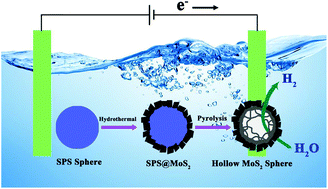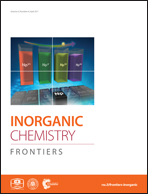Porous hollow MoS2 microspheres derived from core–shell sulfonated polystyrene microspheres@MoS2 nanosheets for efficient electrocatalytic hydrogen evolution†
Abstract
Porous hollow MoS2 microspheres were fabricated from core–shell monodisperse sulfonated polystyrene (SPS) microspheres@MoS2 nanosheets by pyrolysis at 800 °C under a N2 atmosphere. SPS microspheres were employed as the template and carbon precursor. The composite was characterized by powder X-ray diffraction (PXRD), Raman spectroscopy, scanning electron microscopy (SEM), transmission electron microscopy (TEM), N2 adsorption and X-ray photoelectron spectroscopy (XPS). The unique hollow structure not only enlarges the specific surface area and increases Mo-edge active sites, but also facilitates the diffusion of the electrolyte. Furthermore, the residual porous carbons in the hollow MoS2 microspheres were produced due to the incomplete decomposition of SPS, which will enhance the conductivity of the composite, thus promoting the electrocatalytic activity of hydrogen evolution. The as-prepared porous hollow MoS2 exhibits a low overpotential of 90 mV associated with a low Tafel slope of 51 mV per decade and excellent stability in the hydrogen evolution reaction (HER).

- This article is part of the themed collection: Inorganic Chemistry Frontiers HOT articles for 2017

 Please wait while we load your content...
Please wait while we load your content...